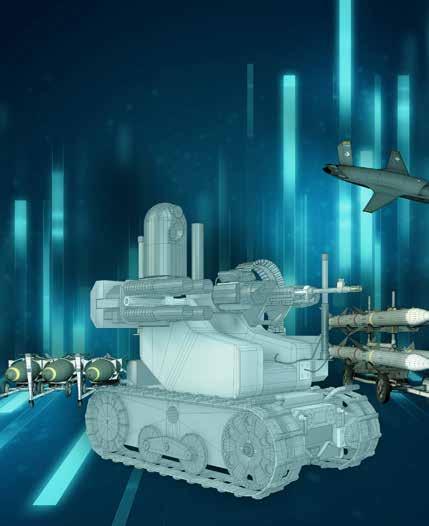
5 minute read
PROMOTING OPERATOR LETHALITY THROUGH ADVANCED TECHNOLOGY
COL Ryan Barnes is currently the director of U.S. Special Operations Command’s Joint Acquisition Task Force (JATF). The JATF provides proof of concept prototypes filling capability gaps at the farthest tactical edge of SOCOM’s future operating concept. Currently, the focus is on hyper-enabling SOF operators in partner-nation operations. Previously, he served as Chief of SOF Ground Systems Operational Test & Evaluation within SOCOM’s J8 directorate, providing oversight to all OT&E for systems acquired by Program Executive Office SOF Warrior. In this role, COL Barnes ensured equipment being fielded by operators was safe, suitable and effective for SOF-specific and SOF-peculiar missions. He received his commission in 1994, previously enlisting in the U.S. Marine Corps as an infantryman and serving as a TOW missile gunner.
COL Barnes separated from the Army in 1999 and accepted a position with Data Quest, Limited as the Vice President of Operations, managing more than 100 employees located in offices nationwide. He re-entered service in 2001 after witnessing the September 11, 2001 terrorist attack in New York firsthand from Manhattan. He re-entered the Army as a Civil Affairs officer where he commanded a Civil Affairs Tactical Support Team in Iraq for 13 months supporting 3rd Bn, 3rd Special Forces Group (Airborne) in special operations and intelligence work. Col. Barnes later worked at Massachusetts Institute of Technology–Lincoln Labs where he oversaw and managed operations and security for 53 classified research and development programs for the U.S. government worth more than $195 million.
Advertisement
Armor & Mobility had the chance to speak with COL Ryan Barnes, Director of USSOCOM’s Joint Acquisition Task Force (JATF), regarding some of SOCOM’s target capabilities procurement efforts going forward in 2020 and beyond.
A&M: With SOCOM’s evolution from TALOS to Hyper-Enabled Operator (HEO), what are primary variations of enhanced capability?
COL Barnes: TALOS was focused on physical performance and personal protection. HEO is focused on cognition and decision making: enabling operators to make better decisions faster. This objective entails being able to acquire raw data, extract meaningful information from that data, and present the relevant data to the right operator in an easily understandable format and timely manner.
A&M: As HEO offers an enhanced system architecture, talk about primary aspects of comms, computing and interfacing for the user?

COL Ryan W. Barnes Director Joint Acquisition Task Force U.S. Special Operations Command
COL Barnes: In a lot of ways, HEO is about doing for operators what smart phones do for consumers and virtual dashboards do for executives. A smart phone gives its user instant access to the internet and all of the information stored there, and dashboards provide executives the right amount of information to monitor business activities and make relevant decisions. Executive dashboards are populated from inputs across an enterprise and are available to augment decision making with the right amount of information, at the right time and in an easily understandable format.
If you want to go for dinner in an unfamiliar city, you can use the phone to identify restaurants by your preferred cuisine, read reviews to evaluate which are best, book a reservation, and get turn-by-turn driving directions that account for current traffic conditions, all with a single device that fits in your pocket. Our issue is smart phones assume a reliable connection to the internet, which requires a robust network and necessitates computation on remote servers.
Special Operations Forces (SOF) operators need to be able to work in austere and contested or denied environments. In many cases, they
are unable to depend on reliable connections to remote servers. Consequently, the HEO places a heavy emphasis on edge computing and unconventional communication modes. That said, communications and computing will not – by themselves – hyper-enable the operator. To be useful, the HEO solution needs to present information to the operator and allow the operator to make inputs. A HEO system’s interfaces need to be non-intrusive and maximally intuitive so the system supplements rather than interferes with the operator’s ability to complete the mission. This needs to happen seamlessly with or without conventional communication capabilities.
A&M: With advancements in artificial intelligence continuing, how will AI enable proactive data collection and qualification for operator
The SOF Hyper-Enabled Operator (HEO) effort encompasses these primary tenants. (USSOCOM)

decisiveness?
COL Barnes: Simply dumping data on the operator will not improve decision making. In a HEO system, AI is needed to quickly extract the important information from the sea of available data and present it to the operator quickly in a situationally-relevant and intuitively understandable way. The technology needs to be operator focused to augment their abilities, rather than having to re-educate operators and/or re-invent their tactic, techniques and procedures to maximize the technology.
A&M: What are some milestones expected moving forward?
COL Barnes: Our internal milestones involve iterative development and testing of the HEO architecture throughout fiscal year 2020 with prototype capabilities layered on that framework. We are maximizing contact with SOF operators to remain focused on their needs and missions to garner early feedback on technology developments. Our task this year is to establish the HEO software architecture, perform proof of concept experiments for our unconventional communications and operator-worn kit lines of effort, integrate commercial computer applications, and initiate lines of effort for a HEO display/presentation layer and a data analytics layer.
NDIA JOINT ARMAMENTS, ROBOTICS, & MUNITIONS CONFERENCE & EXHIBITION
SAVE THE DATE
Join key members of the Armaments, Robotics, and Munitions communities at this newly combined event to explore topics, products, and processes of common interest. Whether it be investigating the full spectrum of capabilities within armament and robotics systems, or discovering the key to an agile and responsive munitions enterprise, this conference offers it all—briefings, speeches, breakout sessions, exhibits, and even a live-fire demo. You won’t want to miss this hands-on opportunity to explore innovative technologies.
September 27 – 30, 2020 Columbus, GA | NDIA.org/JARMCE






